Welcome to the fascinating universe of subwoofer box designs! Whether you're a dedicated audiophile or just someone who revels in the deep resonance of bass, you've landed in the perfect spot. This article will delve into the distinct characteristics that set 4th order bandpass vs 6th Order Bandpass subwoofer boxes apart. These two designs are at the forefront for anyone looking to elevate the bass performance of their sound system. The decision to opt for a 4th order bandpass or 6th-order bandpass box is crucial, as it influences the overall sound quality, efficiency in handling power, and the spatial demands of your audio setup.
Embarking on this journey, we'll uncover which bandpass Order might best match your sonic preferences. The comparison between 4th vs 6th Order Bandpass subwoofer boxes isn't just about technical specs; it's about matching the right acoustics to your audio desires. Understanding the nuances of these designs will empower you to make an informed choice, ensuring that your audio system resonates with your expectations regarding bass clarity, depth, and power. But WHY do you want to do a 6th order bandpass? Or bandpass in the first place? What are the benefits you are gaining from that enclosure?
Understanding Subwoofer Boxes
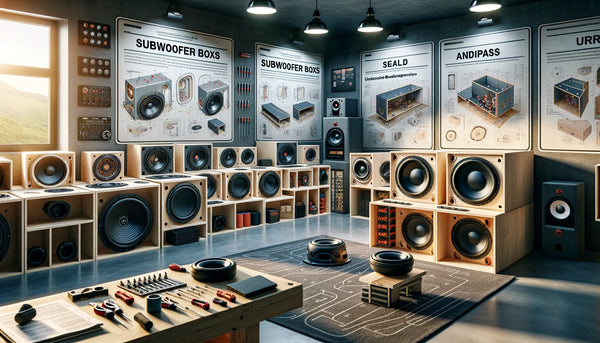
Regarding car subwoofers, the enclosure plays a crucial role in shaping the audio output. Subwoofer boxes, or enclosures, are specially designed structures to house subwoofers. They are not just a box to contain the subwoofer but rather an important component that controls the movement of the subwoofer diaphragm and, ultimately, the sound it produces. The type of subwoofer box you choose, such as a db box, can significantly impact your subwoofer's frequency response, precision, and overall audio performance.
What is a Subwoofer Box?
A subwoofer box, called an enclosure, is a purpose-built housing designed to hold subwoofers. It serves the dual role of protecting the subwoofer components and optimizing the audio output. The enclosure ensures that the subwoofer operates efficiently by isolating the sound waves the subwoofer produces, delivering an optimal bass response. This is achieved by designing and constructing the subwoofer box, which considers factors such as the subwoofer's frequency response, the enclosure's internal volume, and the port or vent size.
Importance of a Subwoofer Box
The importance of a subwoofer box cannot be overstated. It is crucial in enhancing low-frequency audio precision, which is essential for achieving high-quality sound reproduction. An adequately designed subwoofer box prevents the cancellation of low-frequency sounds, ensuring the bass response is robust and accurate. Moreover, subwoofer boxes contribute to the overall audio system efficiency by controlling the rear chamber air volume, providing the subwoofer with the necessary parameters to maximize its performance. Whether you are a music lover, a movie enthusiast, or simply someone who enjoys deep bass, having the correct subwoofer box is paramount in achieving the desired audio experience.
4th Order Subwoofer Boxes
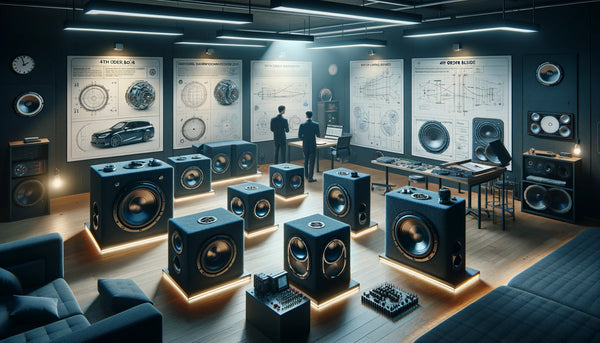
Now, let's delve into 4th-order bandpass subwoofer boxes. These enclosures offer a hybrid design, combining the characteristics of sealed and ported enclosures to create a unique sound signature. By using the rear chamber to interact with the subwoofer, 4th-order bandpass subwoofer boxes can influence the frequency response and optimize the low-frequency output. Look at the basics, pros, and cons of 4th-order sealed box subwoofer boxes.
Basics of 4th-Order Subwoofer Boxes
4th order subwoofer boxes, also known as 4th-order bandpass subwoofer boxes, are a hybrid design that combines the characteristics of sealed and ported enclosures. These enclosures comprise two chambers, separated by a sealed rear chamber and a ported front chamber. The sealed rear chamber acts as a low pass filter, allowing only low-frequency sounds to pass through, while the ported front chamber serves as a high pass filter, allowing only higher-frequency sounds to pass through. This interaction between the sealed rear chamber and the ported front chamber creates a unique frequency response that emphasizes specific low-frequency bands, enhancing bass performance. Thread Tools, such as Q(ms), can calculate the performance of 4th order subwoofer boxes and determine the best configuration for optimal sound quality.
Pros of 4th-Order Subwoofer Boxes
- Enhanced frequency response: 4th-order subwoofer boxes are designed to deliver a specific frequency response, often tailored to the subwoofer's capabilities, resulting in enhanced low-end performance.
- SPL (Sound Pressure Level) boost: The enclosure design of 4th-order subwoofer boxes enables them to produce higher sound pressure levels, providing a more impactful bass experience.
- Increased bass output: 4th-order subwoofer boxes excel in producing a robust and tight bass response, delivering deep and punchy low-frequency audio.
- Improved linearity: Thanks to the sealed rear chamber, 4th-order subwoofer boxes minimize distortion, resulting in cleaner and more accurate bass reproduction.
- Optimal subwoofer efficiency: With their precise tuning, 4th-order subwoofer boxes can optimize their efficiency, allowing them to perform at their best in the low-frequency range.
Cons of 4th Order Subwoofer Boxes
- Reduced bandwidth: 4th-order subwoofer boxes have inherent limitations in bandwidth, emphasizing specific low-frequency bands while potentially sacrificing the overall frequency range.
- Challenging enclosure design: The complexity of 4th-order subwoofer boxes can pose challenges for DIY enthusiasts, as achieving the desired frequency response may involve meticulous adjustments and testing.
- Cutoff frequency limitations: The cutoff frequency, which determines the point at which the rear chamber begins filtering the low-frequency sounds, needs to be carefully chosen to ensure optimal performance, requiring advanced audio engineering knowledge.
- Rear chamber considerations: The sealed rear chamber in 4th-order subwoofer boxes requires careful design considerations, including the volume and damping, to achieve the desired bass response, adding complexity to the enclosure construction.
What is the difference between a 4th order and a 6th order bandpass?
The main difference between a 4th order and a 6th order bandpass is the steepness of the roll-off slope. A 4th order bandpass has a 24 dB/octave slope, while a 6th order bandpass has a steeper 36 dB/octave slope. This results in better control and precision in filtering frequencies.
6th Order Subwoofer Boxes
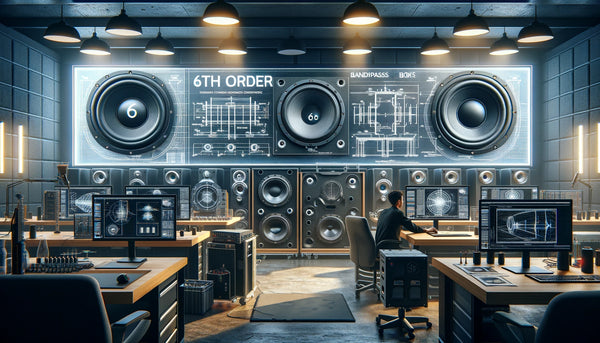
Moving on, let's dive into the world of 6th Order bandpass subwoofer boxes. These enclosures take the concept of bandpass design even further, offering more control over the subwoofer's frequency response and bass output. Using two separate chambers, a sealed rear chamber, and a ported front chamber, 6th-order subwoofer boxes can fine-tune the low-frequency response, delivering powerful and extended bass performance. With a frequency response that rolls off at a rate of 6dB per octave, these boxes are ideal for producing deep and punchy bass while minimizing the impact of the filter on the response. Let's dig deeper into the basics, pros, and cons of 6th-order subwoofer boxes.
Basics of 6th-Order Subwoofer Boxes
6th-order subwoofer boxes, also known as 6th-order bandpass boxes, are designed to optimize the low-frequency response of the subwoofer by utilizing the interaction between two chambers. The rear chamber is sealed, acting as a low pass filter, while the front chamber is ported as a high pass filter. This combination allows 6th-order subwoofer boxes to deliver a wider bandwidth and extended bass response than 4th-order subwoofer boxes. The precise tuning of the rear chamber and the ported front chamber results in controlled low-frequency precision, impactful bass, and enhanced subwoofer performance, making the box a crucial component in achieving optimal sound quality.
Pros of 6th Order Subwoofer Boxes
- Extended low-frequency response: 6th-order subwoofer boxes deliver an extended low-frequency response, allowing for reproducing sub-bass frequencies with precision.
- Increased sound pressure levels: Their ported chamber design allows 6th-order subwoofer boxes to produce higher sound pressure levels, resulting in a more forceful and immersive audio experience.
- Wider bandwidth: 6th-order subwoofer boxes offer a broader bandwidth, allowing for a more comprehensive range of low-frequency audio, capturing the sub-bass spectrum with exceptional detail.
- Enhanced frequency response: Thanks to the rear chamber's precise tuning and filtering capabilities, 6th-order subwoofer boxes can optimize the subwoofer's frequency response, enhancing audio performance across the low-frequency range.
- Excellent bass control: 6th-order subwoofer boxes provide exceptional bass control, reproducing bass frequencies with precision and impact.
Cons of 6th Order Subwoofer Boxes
- Complex enclosure design: 6th-order subwoofer boxes have a more complex enclosure design compared to sealed or ported boxes, requiring advanced construction skills and knowledge.
- Space requirements: Due to the larger rear chamber, 6th-order subwoofer boxes require more space for installation, which may limit their usability in specific vehicle or room configurations.
- Less user-friendly for beginners: The intricate setup of 6th-order subwoofer boxes can be challenging, as meticulous attention to detail is required for optimal performance.
- Potential vent noise: The ported chamber in 6th-order subwoofer boxes can introduce the possibility of vent noise, requiring careful design considerations to minimize unwanted artifacts.
- Increased reliance on subwoofer specifications: 6th-order subwoofer boxes may require a closer match between the subwoofer and the enclosure specifications to achieve the desired audio performance.
Comparing 4th and 6th Order Subwoofer Boxes
Now that we understand 4th and 6th-order subwoofer boxes let's compare the two designs. Both 4th and 6th-order subwoofer boxes have unique advantages and limitations, making choosing between the two an important consideration when designing your audio system. The following sections will compare the sound quality, space and size requirements, and power handling capabilities of 4th and 6th-order subwoofer boxes.
Sound Quality Comparison
Regarding sound quality, both 4th and 6th-order subwoofer boxes have their strengths. 4th order subwoofer boxes, with their emphasis on low-frequency precision, excel in delivering accurate bass response, making them well-suited for audio enthusiasts who prioritize tight and controlled low-end performance. On the other hand, 6th-order subwoofer boxes offer a more amplified bass experience, extending the low-frequency response and capturing sub-bass frequencies with more significant impact. The 4th-order subwoofer box may provide your desired precision and definition depending on your audio preferences. In contrast, the 6th-order subwoofer box can add extra bass excitement, especially for genres that rely heavily on sub-bass, such as electronic music.
Space and Size Comparison
Space and size requirements are essential when selecting between 4th and 6th Order subwoofer boxes. 4th order subwoofer boxes, with their hybrid design, tend to be more compact, making them ideal for installations where space is limited. These enclosures offer practicality while still delivering solid bass performance. On the other hand, 6th-order subwoofer boxes, with their larger rear chamber, require more space for installation, making them better suited for setups with ample room. When planning your audio system, consider the available space in your vehicle or living space and the desired level of bass performance to determine which woofer box design will fit best.
Power Handling Comparison
The power handling capabilities of 4th and 6th-order subwoofer boxes can also influence your choice. 4th order subwoofer boxes are designed to efficiently handle power, providing a balanced audio output for moderate power levels. They are suitable for various applications, catering to diverse audio preferences. On the other hand, 6th-order subwoofer boxes can handle higher power, delivering a more forceful audio experience. These enclosures excel in applications where high sound pressure levels (SPL) are desired, making them popular choices in car audio competitions and venues that require bass-heavy audio. Consider the power requirements of your audio system and the desired SPL levels to choose the subwoofer box design that will provide the best power-handling capabilities for your specific needs.
Making The Right Choice
Several factors come into play when choosing between 4th and 6th-order subwoofer boxes. It's essential to consider the available space, the desired frequency response, the power handling requirements, and personal audio preferences. By evaluating these factors, you can make an informed decision and ensure that the subwoofer box you choose aligns with your audio goals. Let's consider the factors when choosing between 4th and 6th-order subwoofer boxes.
Factors to Consider While Choosing between 4th and 6th Order
- Frequency response: Consider the desired frequency response of your audio system. If you prioritize precision and accuracy in the low-frequency range, a 4th order subwoofer box may be the better choice. For a more impactful and bass-heavy audio experience, a 6th-order subwoofer box might be the preferred option.
- SPL requirements: Consider the sound pressure levels (SPL) you want to achieve with your audio system. If you desire high and immersive SPL levels, a 6th-order subwoofer box is more likely to deliver the intense bass you want. However, if you prefer a balanced audio output without compromising on low-frequency precision, a 4th order subwoofer box may be the better fit.
- Bandwidth considerations: The bandwidth, or the range of frequencies the subwoofer box can effectively reproduce, should also be considered. 4th order subwoofer boxes typically have a narrower bandwidth, optimized for specific low-frequency bands. In comparison, 6th-order subwoofer boxes offer a broader bandwidth, capturing a more comprehensive range of frequencies, including the sub-bass spectrum.
- Enclosure and space requirements: Evaluate the available space in your vehicle or living area to determine which subwoofer box design will fit best. 4th-order subwoofer boxes, with their more compact size, are well-suited for setups where space is limited, while 6th-order subwoofer boxes require more room due to the larger rear chamber.
Understanding Your Sound Preferences
Understanding your sound preferences is crucial when choosing between 4th and 6th-order subwoofer boxes. Consider the type of audio you enjoy and the level of bass amplification you desire. If you appreciate accurate low-frequency reproduction and prioritize tight and controlled bass, a 4th order subwoofer box may be the better option. On the other hand, if you enjoy more pronounced and impactful bass, especially in genres that rely heavily on sub-bass, such as electronic music, a 6th-order subwoofer box might be the preferred choice. Knowing your preferred audio experience, whether a precise and focused bass or a more intense and immersive one, will help you select between 4th and 6th-order subwoofer boxes.
Real-World Examples of 4th and 6th-Order Subwoofer Boxes
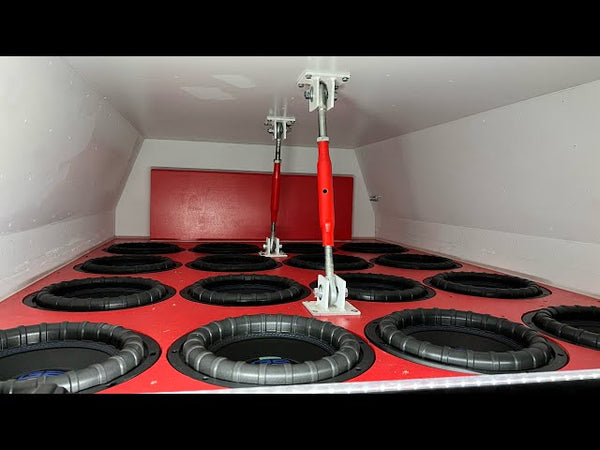
Let's look at real-world examples to understand the capabilities of 4th and 6th-order subwoofer boxes. These success stories highlight the advantages and applications of each subwoofer box design, providing insights into the performance and impact they can have in different audio systems.
Success Stories with 4th-Order Subwoofer Boxes
Users have reported positive experiences with 4th order subwoofer boxes, praising their efficient bass delivery and space-saving design. Success stories highlight the enhanced low-frequency response, balanced audio output, and improved sound quality achieved with 4th-order bandpass subwoofer boxes. Users have also noted the versatility of these enclosures, showcasing their performance in various sound systems, including car audio setups, home theaters, and studio environments. These success stories reaffirm the benefits of 4th-order subwoofer boxes, making them popular among audio enthusiasts and professionals.
Success Stories with 6th-Order Subwoofer Boxes
The success stories with 6th-order subwoofer boxes resonate with those seeking extended low-frequency response, impactful bass, and precision audio reproduction. Users have reported improved bass response, enhanced low-frequency extension, and exceptional audio performance with 6th-order bandpass subwoofer boxes. These success stories highlight the advanced engineering and design of 6th-order subwoofer boxes, showcasing their performance in various audio systems, including car audio installations, home theaters, and live sound setups. The positive user experiences reflect the benefits of 6th-order subwoofer boxes, which provide unparalleled bass control, expansive frequency response, and outstanding low-frequency precision.
Expert Opinions on 4th vs 6th Order Subwoofer Boxes
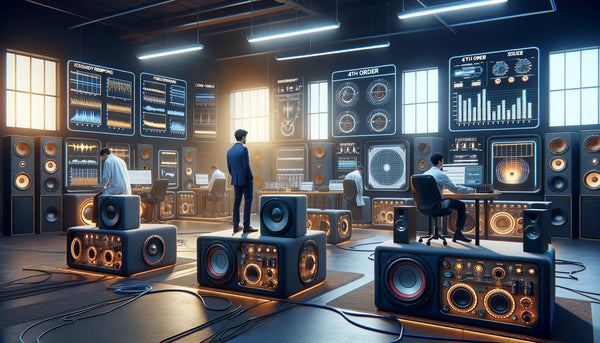
Experts in the audio industry have shared their insights on the comparison between 4th and 6th-order subwoofer boxes, shedding light on the advantages and considerations of each design. Many experts emphasize the benefits of 6th-order subwoofer boxes, particularly for low bass frequencies, highlighting their extended frequency response and controlled bandwidth. The rear chamber design of 6th-order subwoofer boxes, paired with the low pass filter precision, is often praised for its ability to deliver exceptional bass performance. Professionals often recommend 6th-order subwoofer boxes for their advanced filtering capabilities, which optimize the subwoofer's audio output. These expert opinions serve as valuable guidance for audio enthusiasts and professionals when choosing between 4th and 6th-order subwoofer boxes, helping them understand the complexities and nuances of each design.
Common Misconceptions About 4th and 6th-Order Subwoofer Boxes
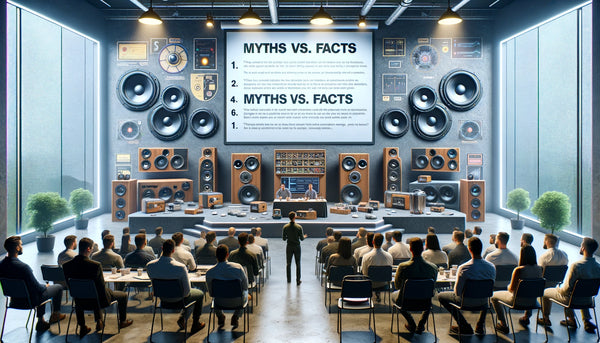
Like any topic, there are common misconceptions surrounding 4th and 6th-order subwoofer boxes. It's essential to address these misconceptions to accurately understand the designs' capabilities and limitations. One common misconception about 6th-order subwoofer boxes is that they prioritize vent size over box volume, which experts debunk, emphasizing the need for a carefully matched rear chamber to optimize the low-frequency response. Another misconception is that 4th-order subwoofer boxes are less capable compared to 6th-order subwoofer boxes when, in fact, they offer distinct advantages, such as enhanced low-frequency precision. By dispelling these misconceptions, audio enthusiasts can make more informed decisions when selecting the subwoofer box design that best suits their audio needs.
Is One Order Better Than the Other?

The debate between 4th and 6th-order subwoofer boxes is ongoing, as both designs offer distinct advantages and trade-offs. It isn't easy to declare one Order superior to the other, as the choice depends on various factors, including the audio preferences of the listener, the desired frequency response, and the available space. While 4th-order subwoofer boxes prioritize low-frequency precision and are more compact, 6th-order subwoofer boxes deliver extended low-frequency response and higher sound pressure levels. The decision ultimately lies in the listener's priorities, audio preferences, and the specific characteristics of their audio system. By evaluating the unique features, pros, and cons of 4th and 6th-order subwoofer boxes, audio enthusiasts can make an informed decision that aligns with their audio goals and provides the best bass performance for their specific setup.
Conclusion

In conclusion, 4th and 6th-order subwoofer boxes have unique qualities and advantages. The choice between the two depends on your sound preferences, available space, and power handling requirements. If you prioritize sound quality and have limited space, a 4th order subwoofer box might be your better option. On the other hand, if you need higher power handling capabilities and have more space to work with a 6th-order subwoofer box could be the way to go. It's essential to consider these factors and consult with experts to make an informed decision. Remember, the goal is to enhance your audio experience and find the perfect balance between performance and practicality.





